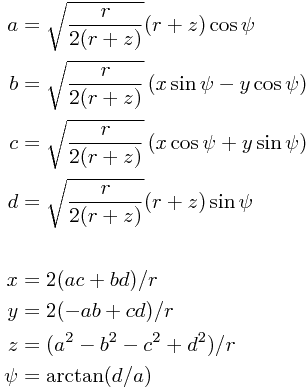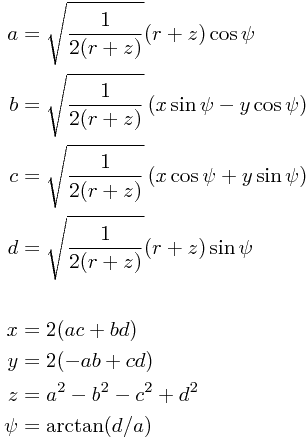Hopf Fibration
The Hopf fibration is a way to represent  as a fiber of
as a fiber of  over
over  .
.
The simplest way of writing this fibration down explicitly relies on the identification of  with the set of all rotations of a coordinate basis in three dimensions, which can in turn be visualized as choosing the direction in which (say) the
with the set of all rotations of a coordinate basis in three dimensions, which can in turn be visualized as choosing the direction in which (say) the  axis points (which is a rotation in
axis points (which is a rotation in  ) and then rotating in the perpendicular plane to choose the other pair of axes.
) and then rotating in the perpendicular plane to choose the other pair of axes.
Coordinate choice 1
Advantage: gives agreement of the radial coordinate.
Extending this by adding a radial coordinate  one finds that the 3D + fiber coordinates
one finds that the 3D + fiber coordinates  can be translated to the 4D coordinates
can be translated to the 4D coordinates  via the map
via the map

This should be supplemented with the choice  for
for  .
.
Note that in this transformation, one has the radii of the spheres in agreement.
The flat metric on  is
is

which translates into a metric in the fibred coordinates of

Coordinate choice 2
Advantage: clearer relation to the flat metric in the three-dimensional space. Has nice expressions for  etc. in terms of
etc. in terms of  etc. (Also one standard form of the near-NUT geometry in Taub-NUT metric.)
etc. (Also one standard form of the near-NUT geometry in Taub-NUT metric.)
Changing the identification of the radial coordinate  one finds that the 3D + fiber coordinates
one finds that the 3D + fiber coordinates  can be translated to the 4D coordinates
can be translated to the 4D coordinates  via the map
via the map

This should be supplemented with the choice  for
for  .
.
We emphasize that the radial directions now scale differently between the two spheres.
The flat metric on  is still
is still

but now this translates into a metric in the fibred coordinates of (noting the factor of 4)

Notice that one has very nice symmetric expressions like
 in these coordinates.
in these coordinates.